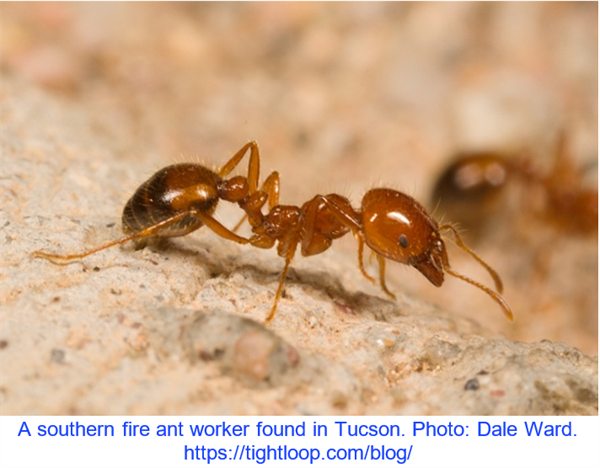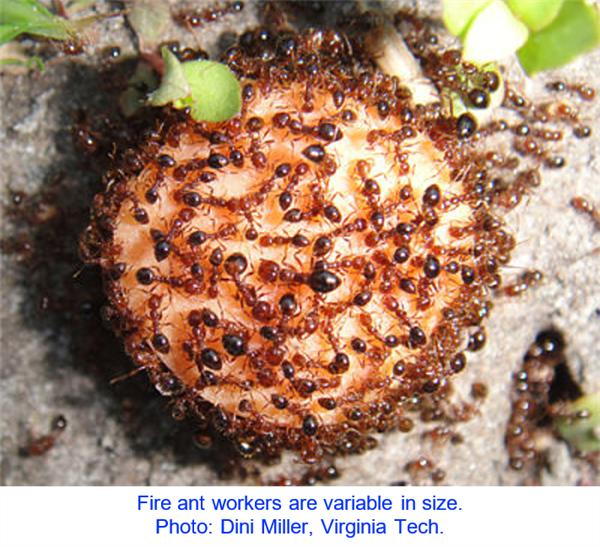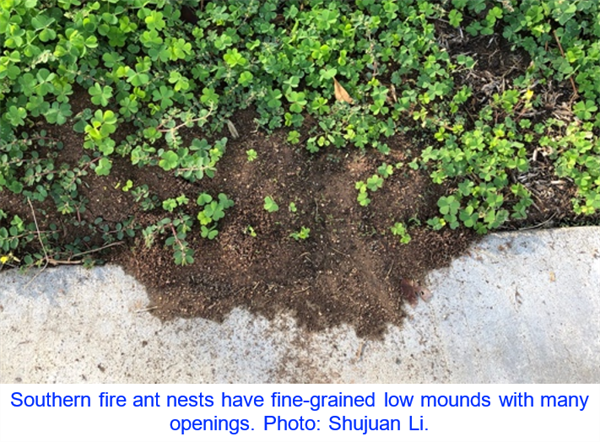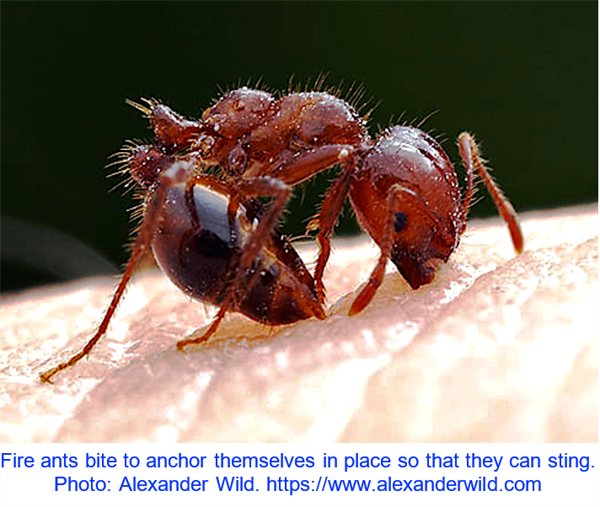
Beware of Fire Ant Stings
Shujuan (Lucy) Li1, Dawn H. Gouge1, Shaku Nair1,
Lawrence (Fudd) Graham2, Alfred J. Fournier1, Kai Umeda1
1. University of Arizona. 2. Auburn University
There are many known species of fire ants (Solenopsis spp.) in the United States, at least three of which are commonly found in Arizona: the native southern fire ant (Solenopsis xyloni), and two species of desert fire ants (Solenopsis aurea and Solenopsis amblychila).

The red imported fire ant (RIFA, Solenopsis invicta) is not established in Arizona, but is found in the southern areas of New Mexico and California. The arid climate in the low desert area is a limiting factor for this invasive species.
Southern fire ants feed on a wide variety of foods, such as insects, sweet foods, grease, proteins, honeydew, and seeds. Candy bars and other nut-containing sweets are among their favorites. Fire ant workers are polymorphic, meaning they vary in size from 1/8 inch to over 1/4 inch in length. Ants are active in the morning and early evening.

Southern fire ants nest in bare soil with direct sun exposure, forming barely identifiable patches of loose soil often near moisture. The colonies do not typically form mounds. When disturbed, fire ants may swarm out of nests and defend their colony by biting and stinging.

Some landscape practices, such as leaving turf or landscape areas bare or compacted, mowing too close to the soil, or edging turf too low with a trimmer, generate ideal conditions for southern fire ants to thrive.
Sensitivity to fire ant stings
Fire ants will bite to anchor themselves in place so that they can sting repeatedly. Their sting contains venom and causes pain. The stings from desert fire ant species are less painful than RIFA stings, but still cause a burning sensation. People vary greatly in their sensitivity to fire ant stings. Some people may experience mild discomfort, while others may be hypersensitive to venom.
Hypersensitive reactions may lead to potentially life-threatening anaphylaxis. Anaphylaxis is a severe, potentially deadly, allergic reaction. It can develop in under a minute, or within 30 minutes of being stung. During anaphylaxis, the immune system triggers release of chemicals that cause the body to go into shock. Blood pressure drops suddenly (victims may look pale or collapse), and airways, through which you breathe, narrow or close causing coughing and/or difficulty breathing. Signs and symptoms of a serious reaction include dizziness and fainting, difficulty swallowing or breathing, slurred speech, nausea and vomiting, chest pain, severe sweating, a rapid but weak pulse, significant swelling, and pallor. Seek immediate medical care, call 911.
What should you do if you are stung?
Individuals, including those who are not known to react severely, should take the following steps if stung by fire ants:

Avoiding fire ant stings

A tri-fold brochure of this publication can be found here: https://acis.cals.arizona.edu/docs/default-source/community-ipm-documents/public-health-ipm/border-2020-outputs/trifold-ant-stings-english-vf.pdf
Video on Arizona Scorpions
We are pleased to share with you a video that we recently created on scorpions in Arizona. This video covers the scorpions commonly found in Arizona, their biology and behavior. It also demonstrates how to inspect for scorpions using a UV light at night. The take-home-message is that scorpions are beneficial predators and an interesting feature of the Desert Southwest.

Save the Dates! The 4th Arizona School IPM Conference will be offered online April 19-30, 2021. The conference is a great opportunity for continuing education, professional development and awareness building; consisting of engaging presentations for all persons involved with schools, childcare and similar facilities in Arizona; and anyone with an interest in ensuring safe, healthy learning and working environments. Listen to talks by experts on various aspects of school IPM, share your experiences and questions, discuss strategies and find solutions to pest issues your school is facing. Give feedback on topics you would like to see in future events. More information available at https://acis.cals.arizona.edu/community-ipm/events/arizona-school-ipm-conference.
Who can attend? Anyone with an interest in safe and effective pest management in schools, childcare and similar facilities. Typically, our audience includes school and other administrative staff, maintenance and operations staff, grounds and landscape managers, teachers, principals, nurses, parents, and pest control technicians, food service staff, facility managers, superintendents, medical professionals, students, and many others.
Invasive Woody Plant Management – Part 2 of 2, March 9, 2021
Encroachment of woody vegetation threatens the biology and ecology of many types of ecosystems. The loss of natural foragers, fires, human-caused disturbance, and the introduction of non-native plants combine to impact native vegetation and its associated wildlife. Removing invasive woody species improves the function of local ecosystems and opens the landscape to provide more suitable habitats for birds and other wildlife. This webinar is the second of a two-part series on managing invasive woody plants and will cover oriental bittersweet, honeysuckle. Attendees will learn the IPM practices used to provide cost-effective management of these woody invasive plants such as mechanical removal (multiflora rose, Japanese barberry, and cutting and shredding), herbicide treatments, fire, and biological controls. In addition, participants will learn how to identify these species and to develop IPM-based strategies for their prevention and control in your region. Register Now
The Vector Preparedness Virtual Workshop is a great opportunity for anyone with an interest in learning information on mosquito ID, surveillance, management, and insecticide resistance in public health pests.
This workshop will present:
Arizona certified structural pesticide applicators can earn 4 CEUs from the AZ Department of Agriculture’s Pest Management Division (PMD) after completing the entire workshop. This course will be effective through August 30, 2021.
For more information contact Dr. Lucy Li, Associate in Extension - Public Health IPM, at lucyli@email.arizona.edu at University of Arizona
Check out upcoming Integrated Pest Management Webinars at https://www.epa.gov/managing-pests-schools/upcoming-integrated-pest-management-webinars
To view all our previous newsletters, visit: https://acis.cals.arizona.edu/community-ipm/home-and-school-ipm-newsletters
Acknowledgements
This material is in part funded by the National Institute of Food and Agriculture, U.S. Department of Agriculture, under award number 2017-70006-27145 that provides Extension IPM funding to the University of Arizona. Information regarding this document is within the guidelines of the Border 2020 Program funded by the U.S. Environmental Agency (EPA) and administered by NADB. Additional support is provided by the U.A. – Arizona Pest Management Center.
